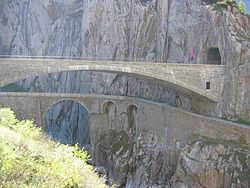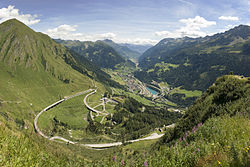Gotthard Pass
| Gotthard Pass |
|---|
St. Gotthard Pass (Italian: San Gottardo) (el. 2108 m.) is a high mountain pass in Switzerland between Airolo in the canton of Ticino, and Göschenen in the canton of Uri, connecting the northern German-speaking part of Switzerland with the Italian-speaking part, along the route onwards to Milan.
Though the pass was locally known in antiquity, it was not generally used until the early 13th century, because it involved fording the turbulent Schöllen, swollen with snowmelt during the early summer, in the narrow steep-sided Schöllenen Gorge (the Schöllenenschlucht), below Andermatt. As early as 1236, it was dedicated to the Bavarian Saint Gotthard of Hildesheim.
The Devil's Bridge

The Pass can be reached by crossing the Schöllenenschlucht and several bridges have been built across the River Reuss in order to facilitate this. According to the oral histories of the nearby villages, seasonal deaths resulting from drowning reached a peak in April-May of most years and thus a safer crossing was required [citation needed]. The original bridge (the Teufelsbrücke) built under these challenging conditions was one of so many Devil's Bridges that the legends about them form a category in the Aarne-Thompson classification system for folktales (number 1191).
The legend of this particular bridge states that the Ruess was so difficult to ford, that a Swiss herdsman wished the devil would make a bridge. The Devil appeared, but required that the first to cross would be given to him. The mountaineer agreed, but drove a goat across ahead of him, fooling his adversary. Angered by this sham, the devil fetched a rock using which he wanted to smash the bridge, but an old woman drew a cross on the rock such that the devil couldn't lift it anymore. The rock is still there, and in 1977, 300,000 Swiss francs were expended to move the 220 ton rock by 127 metres in order to make room for the new Gotthard road tunnel.
The bridge permitted traffic to follow the Reuss to its headwaters and over the saddle at the top—a continental divide between the Rhine, which flows into the North Sea and the Po, which flows into the Mediterranean—then down the Ticino towards Milan. It carried only foot traffic and pack animals until 1775, when the first carriage made the journey on an improved road.
Tunnels through the Pass

Several tunnels provide access through the pass. The 15-kilometer-long Gotthard Rail Tunnel was the first and opened in 1882 for railway traffic at a cost of around 200 workers' lives (there is uncertainty as to the exact toll). It replaced the pass road, connecting Göschenen with Airolo.[1].
A 17 km motorway tunnel, the Gotthard Road Tunnel opened in 1980. It was closed for two months in 2001 following a fatal fire.
A second rail tunnel through the pass, the Gotthard Base Tunnel, is currently under construction. When completed, it will be the longest rail tunnel in the world at 57 km. This tunnel, combined with two shorter tunnels planned near Zürich and Lugano as part of the AlpTransit initiative, will reduce the 3 hour 40 min rail journey from Zürich to Milan by one hour, while increasing the size and number of trains that can operate along the route because the line is nearly level, compared with the spirals of the older tunnel.
Paintings of the Pass
A number of international artists have been inspired by the dramatic scenery of the St. Gotthard Pass, the Schöllenen Gorge and the Teufelsbrücke.
-
Construction of the Devil's Bridge, Carl Blechen, c. 1833
-
The Teufelsbrücke, St. Gotthard by J.M.W. Turner c. 1803.
-
Field Marshal Alexander Suvorov Crossing St. Gotthard Pass, by Alexander Kotzebue.
References
- ^ Hans-Peter Bärtschi: Gotthardbahn in German, French and Italian in the online Historical Dictionary of Switzerland, 2004-07-29.



